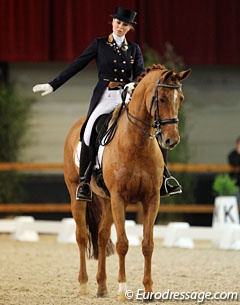
A dressage test typically takes about 6 minutes to complete and of those 6 minutes the first centreline is where the judges get the first impression of you and your horse. I have often watched riders stagger down the first centreline, plop into the halt, wobble out of it, and then get right up to C before making a wiz bang turn to the left or right, without any warning of which way they might be going. I am often on the edge of my seat, wondering, will he go left or right?
The dressage test is designed to test the elements of training and so many basic things are on show within that first centreline alone. First of all, is the horse straight? Are the quarters in? Is the horse's neck in front of the vertical with even weight in both reins?
Secondly, is the horse engaged, which is of course put to the test when the horse halts. If the horse halts with his legs out the back, he was not engaged. If a horse halts with his arse to the right, he was not straight. If a horse halts on the forehand, abruptly, with his nose on his chest, or in some sort of reining nose dive, he was not with his weight to the back and is, therefore, moving with his weight on his shoulders.
If the rider gives the aid to trot off and the horse ignores it, sniffs the air, staggers drunkly off into a sort of trot-walk, he is not on the rider’s aids. If the rider has to ask the horse to trot off three or mores times, the judge is thinking, "oh great, the horse is asleep and the rider is in for one hell of a workout."
The rider should touch the horse and he should step up and out into a collected trot, a trot with expression and impulsion, and this trot should be the same from the first step to the fourth step, and not be gradually introduced on some sort of linear curve towards impulsion.
Finally, and what I what to focus on, is what happens after the halt, right up until the turn at C. A rider must begin to prepare the turn at C, from the minute they step out of the halt. This does not mean that they move off the line. Quite to the contrary, they must be able to flex and gradually bend the horse toward the direction they will turn, setting up the horse to make a wonderfully fluid curve around the turn, a full body curve, and they must do all this without moving one centimetre off the straight centreline.
One great exercise I find to help with this is on the three quarter line. You can begin at walk, walking up the three quarter line and bending for four stride to the left, curving the horse around your left leg, then bending for four strides to the right. This is done very gently, smoothly. Not by pulling the horse with the rein, but by bending him with your upper body, seat and legs. Adjusting the inside rein and allowing with the outside rein, and giving him length in front in order to step up and under behind.
The concept of straightness is a never-ending learning curve in itself, but after having asked for the flexion or bend once you begin to feel what the hind legs are doing, you can begin to learn to control the hind quarters by riding the horse straight and placing that inside hind correctly under the centre of mass. The horse will then be in shoulder fore every step. Through this you can learn to straighten the horse from the back to the front, while working on the suppleness of the horse. Then you can begin to feel this concept at the trot. Learning to place the horse in balance and keeping him straight without changing the line, is a very useful technique. It helps to gain suppleness and flexibility through the horse's body.
This is not an exercise where you see-saw the horse from one side to the other. This is to be done with lightness, softness, helping you to feel the horses muscles and neck line, lengthening and stretching, all the while allowing you to control the body of the horse, and the geometrical line of your direction. Once you can establish this, you can take the final line and gently ease the horse into bend left, while remaining straight on the centreline, and then curve him around your leg as you turn and continue on with the rest of your test.
by Sarah Warne - Photo © Astrid Appels